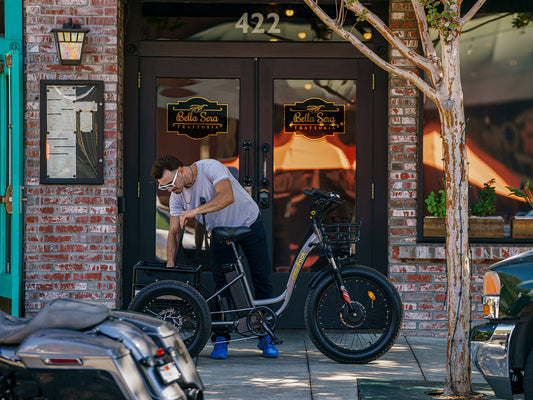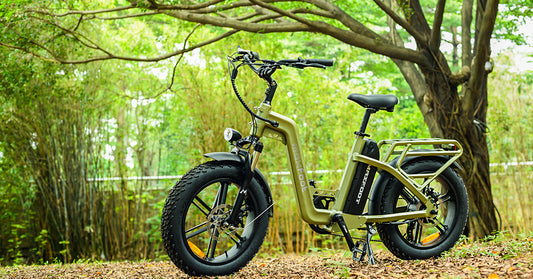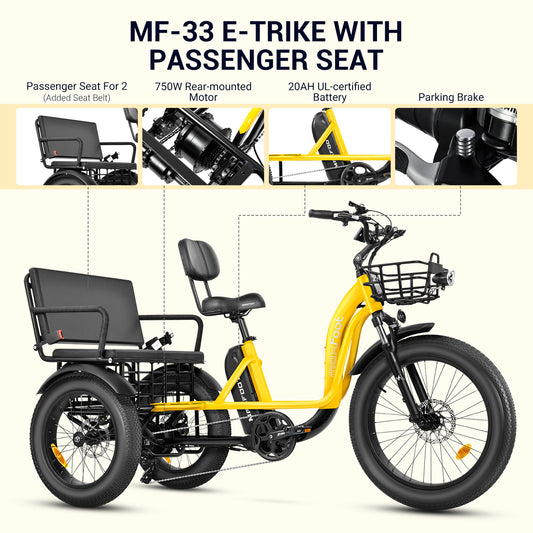The 750W e-bike, a prevalent model among enthusiasts and commuters alike, is known for its performance. This increasing popularity of electric bikes in the United States has spawned several discussions, one of the most common being "How fast does a 750W electric bike go?"
Theoretically, with a 750W motor, an electric bike can reach speeds upwards of 20-28 miles per hour (mph) unassisted on flat terrain. These speeds might vary with rider input, as most e-bikes are designed to augment human power rather than replace it entirely.
While this answer might initially appear straightforward, it's influenced by various factors such as regulations, rider weight, terrain, and battery power. This article explores the speed potential of a 750W electric bike in the US.
Let’s begin with the basics and dig into the speed potential of a 750W electric bike.
What does Wattage Mean for an Electric Bike?
The wattage of an electric bike refers to the power output of its electric motor. It's a measure of the rate at which the motor uses energy, and in simple terms, it is used to indicate the motor's capacity.
The higher the wattage of an e-bike's motor, the more power it can deliver. This power directly influences the speed and torque of the e-bike, enabling it to climb hills easier, carry heavy loads, and maintain higher speeds. However, it's important to remember that while higher wattage often means more power and potential speed, it can also drain the battery faster.
A lower-wattage motor, might not offer the same level of power and speed but will provide a greater range due to lower energy consumption. This makes them ideal for longer, more relaxed rides or commutes where top speed isn't the primary concern.
Typically, electric bikes come in a range of motor power levels, commonly starting from 250W, and going up to 1000W. Each power level offers different performance characteristics:
- 250W:Ideal for flat terrains and lighter riders, offering sufficient power for general commuting and leisure riding.
- 350W: Provides a bit more power, suitable for slight inclines and medium distances.
- 500W: Suitable for longer distances and capable of handling moderate hills, these e-bikes offer a balance between speed, torque, and efficiency.
- 750W: This is a versatile option offering a considerable boost in power, perfect for handling steeper inclines and heavier loads. It's the highest legal limit for public roads in the United States.
- 1000W and above: These offer even more power and speed but are usually only legal for off-road use in many regions. These motors may be coupled with full-suspension, all-terrain ebikes like Maxfoot MF-19, where more power is required to tackle rough terrain.
What is the Legal Speed Limit for 750 W Electric Bikes in the US?
In the United States, federal regulations play a significant role in dictating the maximum speeds for e-bikes. As of the most recent legislation, electric bicycles are divided into three classes:
Class 1: These are pedal-assist bikes with no throttle and can reach speeds up to 20 mph.
Class 2: These e-bikes have a throttle and can attain 20 mph without pedaling.
Class 3: Also known as "speed pedelecs," these bikes require pedaling but can reach up to 28 mph.
Legally, a 750W e-bike is typically classified under Class 2 or 3, depending on its features. However, it's mostly considered as class 2. Therefore, by federal law, the maximum speed it can achieve is restricted to 20 mph (32 kph).
What Factors Influence eBike Speed?
Aside from regulatory restrictions and motor power, a few other factors can influence an e-bike's speed.
Rider Weight
Rider weight is one; heavier riders may find that their e-bike doesn't reach the upper-speed limits. Conversely, lighter riders might exceed them, especially if they're also pedaling vigorously.
Terrain
The terrain also impacts speed. Uphill rides will significantly reduce the bike's top speed due to gravity, while downhill or flat routes allow for higher speeds.
Battery Capacity
The battery's capacity and the bike's overall efficiency will dictate how long it can maintain its top speed before needing a recharge. Achieving top speed means you’re using power and thus draining the battery. So, a small battery won’t be able to sustain top speed for longer periods.
Bike Design:
The bike's design, including factors such as aerodynamics and rolling resistance of the tires, can impact speed. A more aerodynamic bike with high-quality, properly inflated tires will roll more easily and reach higher speeds than a less streamlined design with low-quality or underinflated tires.
What is Unregulated Speed Potential?
Unregulated, a 750W electric bike, like those used for off-road or private property use, can potentially reach much higher speeds, often exceeding 30 mph.
However, doing so not only breaks federal laws if done on public roads but also puts significant strain on the bike's components, potentially leading to premature wear or damage.
How Fast Can Maxfoot Electric Bikes Go?
Maxfoot, a well-respected name in the electric bike industry, offers a range of high-quality e-bikes equipped with motors ranging from 500W to 1000W.
When it comes to the speed capabilities of these bikes, the maximum speed a Maxfoot e-bike can reach is up to 23 mph. In the 750 W range, Maxfoot has three bikes, two cruiser bikes, MF-17, MF-18, and one three-wheel tricycle, MF-30. They can typically reach 20 mph.
These speed limits make Maxfoot e-bikes an excellent choice for both daily commuting and recreational purposes. With the advanced motor systems in these bikes, users can enjoy the benefits of faster speed and significant power, especially helpful for challenging terrains, hill climbing, and carrying heavy loads.
Final Words
In the US, a 750W electric bike's speed is generally limited to 20 or at max 28 mph due to federal regulations. But these speeds can be affected by various factors, including the rider's weight, the terrain, and battery power.
While the bike's unregulated speed may be higher, it's crucial to respect the legal speed limits, ensuring the safety, compliance, and longevity of your electric bike. After all, e-bikes are more about enjoying the ride and the environment than racing at breakneck speeds.




